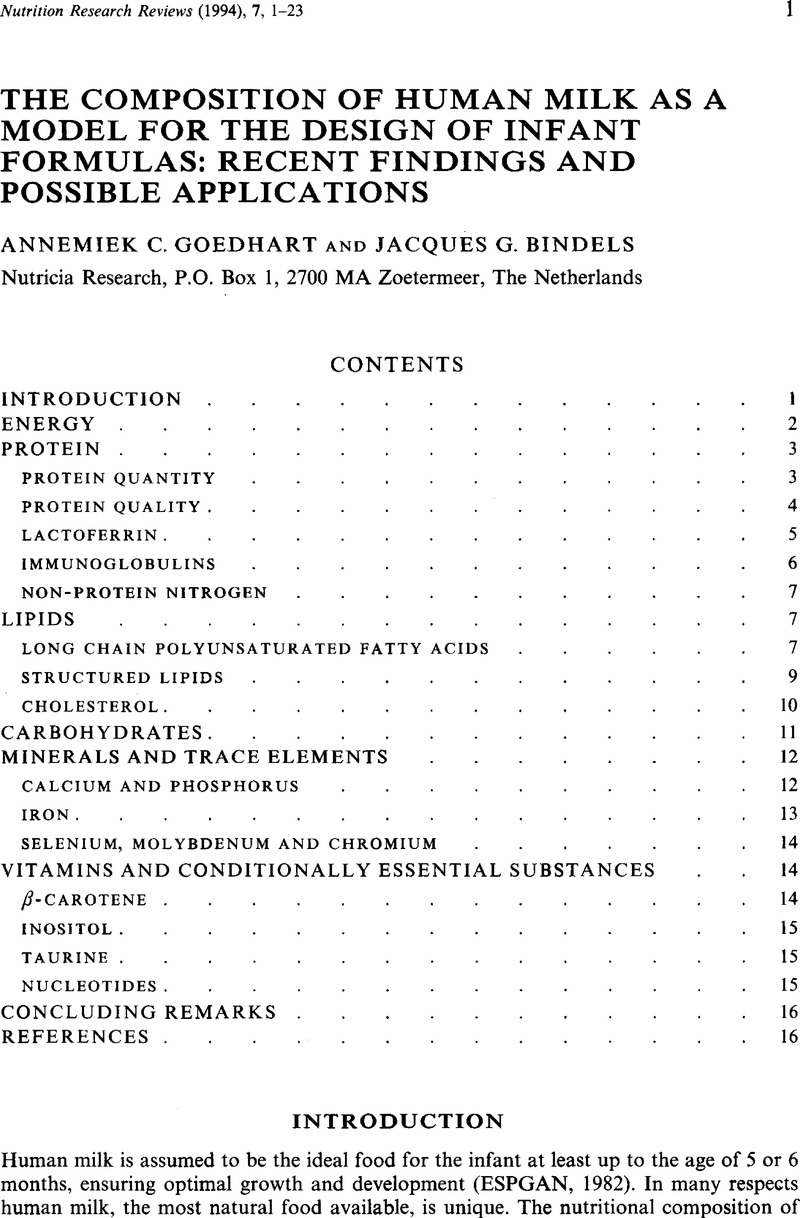Crossref Citations
This article has been cited by the following publications. This list is generated based on data provided by Crossref.
Heinig, M Jane
and
Dewey, Karthryn G.
1996.
Health Advantages of Breast Feeding for Infants: a Critical Review.
Nutrition Research Reviews,
Vol. 9,
Issue. 1,
p.
89.
Foster, L.H
and
Sumar, S
1996.
Hydride generation atomic absorption spectrometric (HGAAS) determination of selenium in term and preterm infant formulae available in the United Kingdom.
Food Chemistry,
Vol. 55,
Issue. 3,
p.
293.
Wells, J.C.K.
1996.
Nutritional considerations in infant formula design.
Seminars in Neonatology,
Vol. 1,
Issue. 1,
p.
19.
Rudloff, Silvia
and
Kunz, Clemens
1997.
Protein and Nonprotein Nitrogen Components in Human Milk, Bovine Milk, and Infant Formula: Quantitative and Qualitative Aspects in Infant Nutrition.
Journal of Pediatric Gastroenterology and Nutrition,
Vol. 24,
Issue. 3,
p.
328.
Rudloff, Silvia
and
Kunz, Clemens
1997.
Protein and Nonprotein Nitrogen Components in Human Milk, Bovine Milk, and Infant Formula: Quantitative and Qualitative Aspects in Infant Nutrition.
Journal of Pediatric Gastroenterology & Nutrition,
Vol. 24,
Issue. 3,
p.
328.
Foster, L.H.
Chaplin, M.F.
and
Sumar, S.
1998.
The effect of heat treatment on intrinsic and fortified selenium levels in cow's milk.
Food Chemistry,
Vol. 62,
Issue. 1,
p.
21.
Leskanich, C. O.
and
Noble, R. C.
1999.
The comparative roles of polyunsaturated fatty acids in pig neonatal development.
British Journal of Nutrition,
Vol. 81,
Issue. 2,
p.
87.
Debier, C
Kovacs, K M
Lydersen, C
Mignolet, E
and
Larondelle, Y
1999.
Vitamin E and vitamin A contents, fatty acid profiles, and gross composition of harp and hooded seal milk through lactation.
Canadian Journal of Zoology,
Vol. 77,
Issue. 6,
p.
952.
Ferreira, Isabel M. P. L. V. O.
Mendes, Eul´lia
Marques, Joana
and
Ferreira, Margarida A.
2000.
DEVELOPMENT, VALIDATION, AND APPLICATION OF AN HPLC/UV METHOD FOR QUANTIFICATION OF CASEIN IN INFANT FORMULAE AND FOLLOW-UP MILKS.
Journal of Liquid Chromatography & Related Technologies,
Vol. 23,
Issue. 13,
p.
2057.
Gurr, Michael I.
2000.
Handbook of Olive Oil.
p.
521.
Salganik, Rudolf I.
2001.
The Benefits and Hazards of Antioxidants: Controlling Apoptosis and Other Protective Mechanisms in Cancer Patients and the Human Population.
Journal of the American College of Nutrition,
Vol. 20,
Issue. sup5,
p.
464S.
Góes, Heloı́sa C.A
Torres, Alexandre G
Donangelo, Carmen M
and
Trugo, Nadia M.F
2002.
Nutrient composition of banked human milk in brazil and influence of processing on zinc distribution in milk fractions.
Nutrition,
Vol. 18,
Issue. 7-8,
p.
590.
Weaver, Lawrence T.
2003.
Improving Infant Milk Formulas: Near the End of the Trail for the Holy Grail?.
Journal of Pediatric Gastroenterology and Nutrition,
Vol. 36,
Issue. 3,
p.
307.
Ferreira, I. M. P. L. V. O.
2003.
Quantification of non-protein nitrogen components of infant formulae and follow-up milks: comparison with cows' and human milk.
British Journal of Nutrition,
Vol. 90,
Issue. 1,
p.
127.
Weaver, Lawrence T.
2003.
Improving Infant Milk Formulas: Near the End of the Trail for the Holy Grail?.
Journal of Pediatric Gastroenterology and Nutrition,
Vol. 36,
Issue. 3,
p.
307.
Aggett, Peter J.
Agostoni, Carlo
Axelsson, Irene
Edwards, Christine A.
Goulet, Olivier
Hernell, Olle
Koletzko, Berthold
Lafeber, Harry N.
Micheli, Jean‐Léopold
Michaelsen, Kim F.
Rigo, Jacques
Szajewska, Hania
and
Weaver, Lawrence T.
2003.
Nondigestible Carbohydrates in the Diets of Infants and Young Children: A Commentary by the ESPGHAN Committee on Nutrition.
Journal of Pediatric Gastroenterology and Nutrition,
Vol. 36,
Issue. 3,
p.
329.
Flack, S.
and
Shaw, V.
2003.
Encyclopedia of Food Sciences and Nutrition.
p.
3288.
Aggett, Peter J.
Agostoni, Carlo
Axelsson, Irene
Edwards, Christine A.
Goulet, Olivier
Hernell, Olle
Koletzko, Berthold
Lafeber, Harry N.
Micheli, Jean-Léopold
Michaelsen, Kim F.
Rigo, Jacques
Szajewska, Hania
and
Weaver, Lawrence T.
2003.
Nondigestible Carbohydrates in the Diets of Infants and Young Children: A Commentary by the ESPGHAN Committee on Nutrition.
Journal of Pediatric Gastroenterology and Nutrition,
Vol. 36,
Issue. 3,
p.
329.
Bramanti, Emilia
Quigley, Wes W.C
Sortino, Chandra
Beni, Francesca
Onor, Massimo
Raspi, Giorgio
and
Synovec, Robert E
2004.
Multidimensional analysis of denatured milk proteins by hydrophobic interaction chromatography coupled to a dynamic surface tension detector.
Journal of Chromatography A,
Vol. 1023,
Issue. 1,
p.
79.
Chuang, Chih‐Kuang
Lin, Shuan‐Pei
Lee, Hung‐Chang
Wang, Tuen‐Jen
Shih, Yu‐Shu
Huang, Fu‐Yuan
and
Yeung, Chun‐Yan
2005.
Free Amino Acids in Full‐Term and Pre‐Term Human Milk and Infant Formula.
Journal of Pediatric Gastroenterology and Nutrition,
Vol. 40,
Issue. 4,
p.
496.



